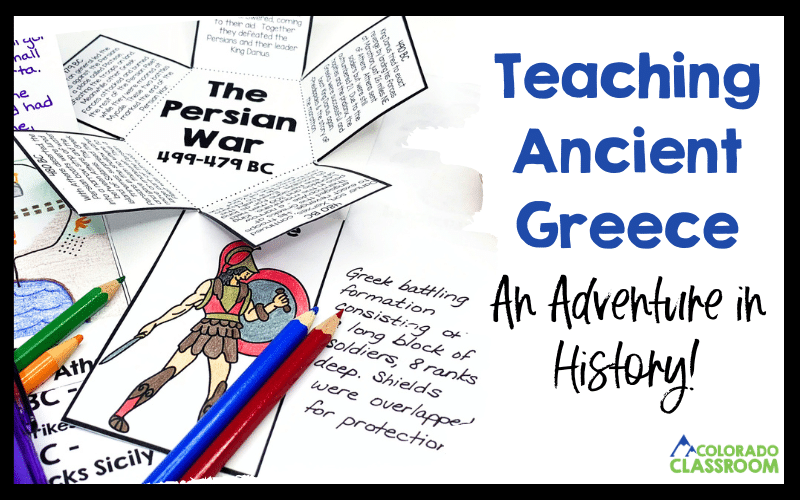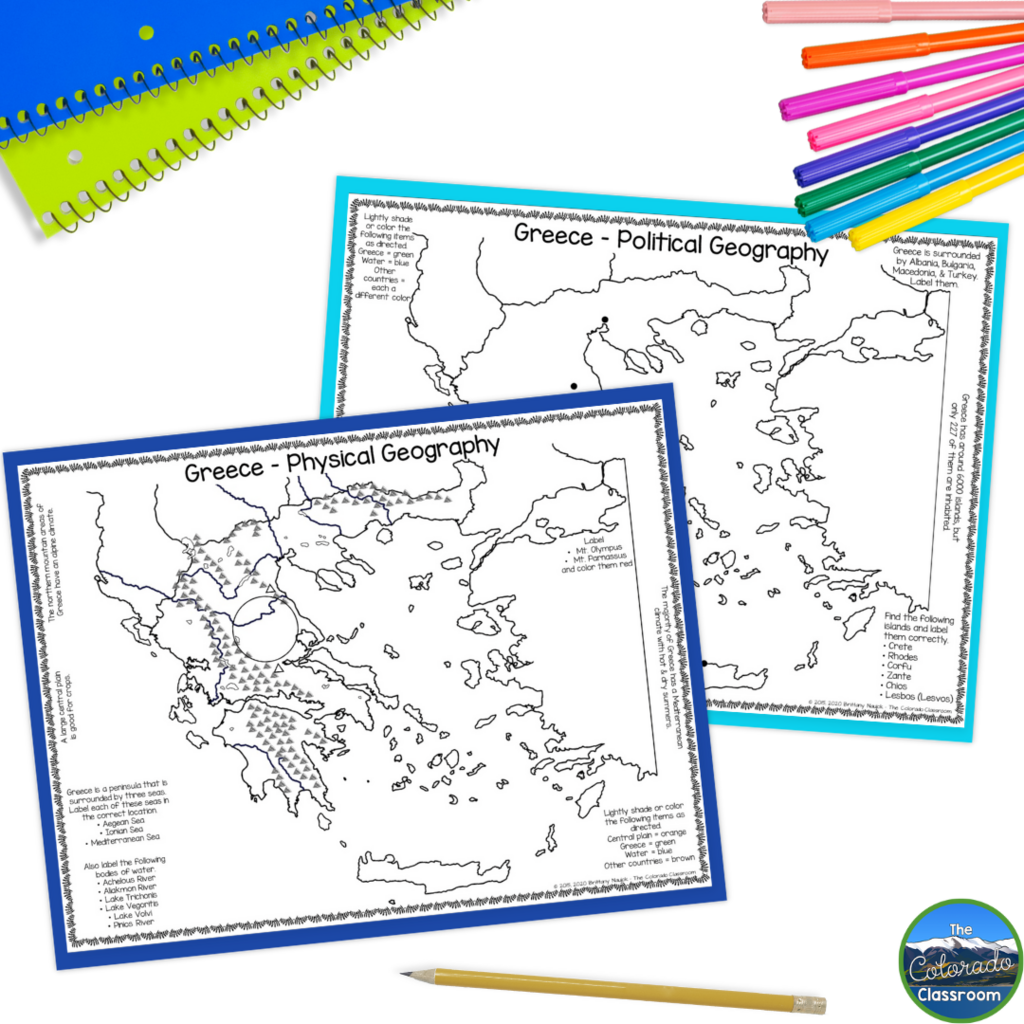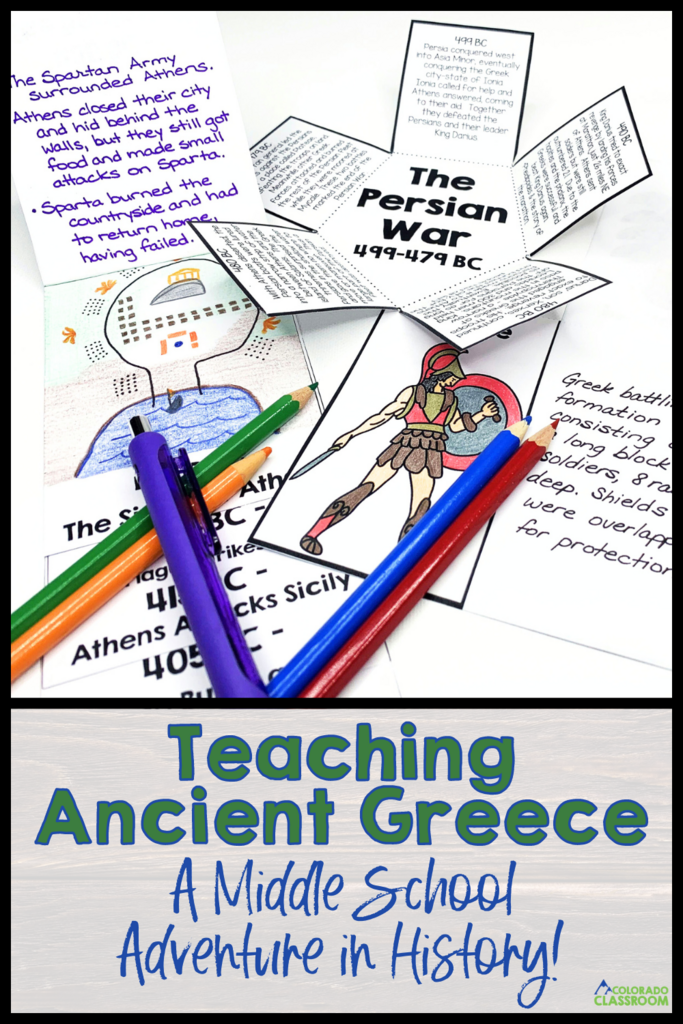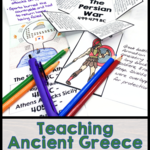Teaching Ancient Greece: A Middle School Adventure in History
Prepare to surprise your students by transforming history into an entertaining and immersive adventure. Teaching ancient Greece is not just a lesson for me. It’s a genuine passion that has evolved into a captivating set of activities designed to make history come alive in unexpected ways. These lessons, crafted with care and refined through years of classroom experience, are more than just a series of facts and dates. Join me and my middle school students as we embark on a thrilling journey through the captivating world of Ancient Greece!

Why Teaching Ancient Greece Will Be a Classroom Favorite
Wondering what to expect in this post? Through hands-on exploration and intriguing stories, we’ll peel back the layers of the fascinating civilization of ancient Greece, making history an unforgettable and enjoyable experience for every student. Get ready to dive into an engaging exploration that goes beyond textbooks, inviting your students to actively participate in uncovering the mysteries of the past. Let’s make this history lesson an adventure they’ll remember!
Meet the Comprehensive Ancient Greece Teaching Resources Bundle

Before diving into the details of how to effectively use this resource, let me give you a sneak peek of what awaits inside. At the heart of our Teaching Ancient Greece bundle lies the Interactive Notebook on Ancient Greece. A vibrant and dynamic resource comprising 11 captivating lessons that promise excitement, knowledge, and hands-on engagement. This unit is carefully crafted and filled with lesson plans, vivid slideshows, illustrative examples of hands-on activities, a diverse array of foldable products, compelling readings, stimulating review games, and interactive tasks.
Your young historians are in for an enriching experience as they delve into the intricacies of Ancient Greece. First, they’ll explore the geography of this ancient land and unravel the complexities of its diverse groups of people. Then, they’ll develop an understanding of the contributions of mathematics and science. Finally, they will be immersed in the drama of wars and the spectacle of the Olympics! This comprehensive unit ensures that the study of Ancient Greece becomes an unforgettable journey. Crafted to breathe life into history, this resource promises to be a memorable chapter in your student’s learning journey. Now, let’s explore how to harness its full potential in your classroom.
Teaching Ancient Greece with Geography
I kick off teaching ancient Greece by immersing my students in a captivating journey through the geography of Ancient Greece. I guide them through visualizing the breathtaking landscapes, navigating rugged terrains, and setting sail across the crystal-clear waters of the Mediterranean. To anchor their understanding, I provide each student with a blank map of Greece along with cloze notes, acting as their compass through this historical landscape.

I utilize the Discover Greece – Geography slideshow to add a visual dimension to our exploration. It brings the historical landscape to life, making the learning experience vivid and captivating. As the students color, label, and engage in discussions using the map, the effectiveness of this interactive approach becomes evident. This visual tool serves not only as a guide but also as a powerful reinforcement of their understanding of Ancient Greece’s geographical features.
Understanding the diverse learning styles in my classroom, I introduce a two-column note page to cater to individual needs. This concise resource allows students to focus on critical details, accommodating varied abilities while ensuring a comprehensive grasp of the subject matter. The goal is to make this geography lesson fun, informative, and tailored to the diverse needs of my students.
Cracking the Code of Ancient Greece Vocabulary
After they have been introduced to the geography of ancient Greece, I present a list of 12 vocabulary words essential to understanding this fascinating civilization. I read through each word with my students, fostering discussions about their meanings and relevance. To provide a hands-on element, I distribute the foldable flash card holders, prompting students to cut and assemble them into their notebooks. This interactive tool becomes their personalized Flash Card Holder, a resource they’ll use throughout our study.

Next, we dive into the creation of vocabulary flashcards with pre-typed words and definitions, adding them to the flash card holder. This step sets the stage for our daily practice, as students use these flashcards to review and reinforce their understanding of the vocabulary words. It’s an important daily ritual that ensures the retention of these terms related to Ancient Greece.
I encourage my students to choose a vocabulary strategy that suits their learning style, whether it’s Four-Fold, Frayer Diagram, or Word Map. This not only enhances their understanding of the words but also allows for individualized exploration, partner collaboration, and small-group engagement.
The crossword and word search activities serve as delightful additions, providing a fun and interactive way for early finishers to reinforce their grasp of the vocabulary words. Teaching Ancient Greece goes beyond rote memorization; it becomes an engaging and immersive experience where language and history intertwine.
Navigating Teaching Ancient Greece with a Timeline

Next, I facilitate an engaging activity to deepen our exploration of Ancient Greece by guiding my students through the creation of a timeline. I provide students with three pages of blank timelines, encouraging them to cut and glue the pieces together in chronological order, forming one continuous timeline. This hands-on approach transforms the abstract concept of teaching ancient Greece historical timelines into a tangible and visual tool.
Ensuring a solid grasp of BC time, I actively guide students during the assembly process, emphasizing the descending order of years as they approach AD and the subsequent ascent after AD. The gluing process involves positioning the rectangular pieces to protrude behind the hexagons, creating a visually cohesive timeline where two hexagons meet at an edge.
As we dive into the general history of Greece, I take on the role of a guide, leading students through the ages and events that shaped this fascinating civilization. I usually teach this lesson as a teacher-directed lesson with a lecture-based approach. This allows me to provide valuable insights and context. Together, we add significant ages and events to the timeline.
City-States with a Focus on Athens and Sparta
This next set of lessons I use for teaching Ancient Greece involves a series of engaging activities over the course of several days. On the first day, we jump into the concept of city-states through the completion of the City-State Thinking Map. This involves a mix of teacher-directed lectures and Socratic questioning, creating a dynamic discussion around key components. If time permits, we also tackle the 3 components of every Greek City-State foldable activity, providing an understanding of the fundamental elements.

Moving to the second and third days, the focus shifts to the creation of the 3D Polis. Using light gray and blank templates, my students construct their own representations of ancient Greek city-states. The variety in their creations always delights me, adding a touch of individuality to our collective exploration.
On the fourth day, we observe the rivalry and differences between Athens and Sparta. I present a color-coded table of comparisons, leading a discussion while my students complete a Venn diagram. They compare the similarities and differences between these two prominent city-states. I make this a collaborative activity by having my students do it in pairs, fostering teamwork and discussion.
The last two days are dedicated to a deeper understanding of the actual workings of a city-state. On day five, we explore the four social classes through teacher-led discussions and Socratic questioning. Students capture their insights on a designated template, assembling their pieces in a special pocket provided for organization.
For the ending of our portion of the teaching ancient Greece activity, which may extend to two days, we complete a four-tab book on the Social World of an ancient Greek city-state. Reading the “Life in Ancient Greece” article, my students use this information to fill in cloze notes on the four-tabbed books. A cutting and gluing activity follows as they construct their personalized books. These become valuable additions to their interactive notebooks that they can refer to throughout the whole study.
Unveiling Ancient Innovators while Teaching Ancient Greece

We then shift gears and construct mini-books while exploring the fascinating article “Giant Brains of Ancient Men.” As a class, we read the narratives of brilliant mathematicians and scientists, as presented in the reading. We engage in lively discussions about their impactful contributions. I often steer the conversation towards contemplating what might have been achieved if women had been afforded the same educational opportunities. This debate usually becomes pretty passionate from all sides!
But the real fun begins when we transition to the hands-on part of the lesson, which is constructing mini-books. Following clear instructions and vibrant illustrations, my students add biographical and historical details to the blank pages.
As the mini-books come together, they become artifacts, documenting our collective exploration of the giant brains that shaped our world. It’s a powerful way to make history tangible, and it’s a memorable part of the broader teaching experience.
Exploring the Olympics while Teaching Ancient Greece
One of my favorite parts of this whole teaching ancient Greece unit is this lesson on the first Olympics! We begin with some background knowledge by reading the article “The Original Olympic Games.” I have my students dissect the evolution of the Olympics, exploring how today’s games differ from the ancient competitions. We look at the role of men and women in sports. For those well-versed in the subject, we dive into the impactful leadership of Theodosius I and the transformative changes he brought to the games’ conclusion.

Now, here comes the hands-on part that truly sets the stage on fire. My students grab their foldable organizers, taking notes under the flaps. The sports question and map activity add an extra layer of engagement, ensuring that every student is actively participating in this exploration.
We shift gears to a creative assignment, which is designing our own Olympic medals. I showcase examples from the past, igniting inspiration among my students. I give my students about 10 days to 2 weeks to work on this artistic endeavor outside of class. In the meantime, I continue on with teaching ancient Greece!
For the grand finale, we organize our own Olympic games using the suggested races and competitions provided. It’s a bonding experience that unites the class and wraps up our journey into the first Olympic Games. With a bracket sheet in hand and ribbons fluttering, the classroom transforms into an arena of camaraderie.
Ancient Gods Accordion Book

During this next lesson on teaching ancient Greece, I guide my students through the different gods and myths that reign supreme in Greek culture. On day one, I lead the charge in a creative escapade armed with scissors and tape. Your students will be crafting an accordion book that pays homage to the legendary figures of Ancient Greece. Tape starts sticking, pages start folding, and before you know it, we’ve crafted a mythical accordion book.
Once we have our books assembled, we delve into passages about gods, sparking discussions and igniting questions. I also introduce a crossword puzzle and a word search for bellringers or early finishers. Who doesn’t enjoy interacting with gods, myths, and a sprinkle of brain-teasing fun? Whether we decode the myths together or let the class go solo, it’s all about merging learning with a dash of excitement.
A Hands-On Exploration of Ancient Greek Governments
While teaching ancient Greece, I try to build in hands-on activities whenever possible. This helps take mundane topics up an engaging notch! In this next lesson, my students and I take an interactive trip into the intricate world of Ancient Greek governments. We fold, compare, and unravel the mysteries of governance with this engaging journey!

Prepared with the mighty shutter fold and definition sheets, my students and I set out to define the eight distinct government types. We don’t just stop at definitions. I have my students add an image or icon to each definition to provide a visual aid for them.
During the next class, we take on the grand comparison between Athenian democracy and its modern American counterpart. Students become detectives, exploring the similarities and differences with a Venn diagram. Partnerships bloom, discussions spark, and the classroom becomes a buzzing hub of comparative analysis.
This isn’t just about charts and diagrams. I have my students take their newfound knowledge and craft an essay that stretches their intellectual muscles. We practice synthesizing information and forming insights.
Exploring Greek Superiority in the Persian War
Next, I’m sharing with you how I immerse my students in the thrilling narratives of the Persian War in our teaching ancient Greece unit. We spend the first day preparing the foldable activity. Scissors are in hand, and vibrant hues fill the room as students explore the strategies that played a pivotal role in Greek triumph during the Persian War.

Once we are prepped, the unfolding of events in the Persian War takes center stage. Together, we traverse historical battlegrounds with the Battle of Thermopylae. I enjoy sprinkling in intriguing facts that might not be well-known. For instance, the Persians built a bridge out of boats to cross the Aegean Sea, which took them seven months! Facts like this one usually hook my students and have them wanting more!
Our exploration takes a deeper turn as we learn about the character of King Leonidas. We reflect on his unwavering commitment, analyze his decision-making during that pivotal moment, and discuss the essence of heroism. Our discussions about leadership, sacrifice, and historical significance reverberate through the room.
For homework or on the third day, I present a challenge. I have my students write an essay on King Leonidas and the profound moment that transcended a mere battle. Students eagerly channel their thoughts onto paper, weaving a narrative that brings history to life through the lens of this extraordinary man.
The Peloponnesian War
As I continue teaching ancient Greece, I make sure to point out the Peloponnesian War. To weave in hands-on learning once again, I have my students get their scissors and glue. They cut out and assembled the components, crafting the structure of a stepbook. Following the step-by-step directions, the process should be a seamless construction that sets the stage for the upcoming historical odyssey.

With the skeletal framework of our stepbook now in place, day two invites us to breathe life into the narrative. The numbered pages serve as beacons, guiding us through the historical events. Using the series of events, I embark on the task of summarizing each event and placing these summaries on the upper flaps of our stepbooks.
A canvas of creativity unfurls as my students, armed with their vivid descriptions, transition to the lower flaps of each step. Here, artistic expressions come to life as they draw illustrations mirroring the events chronicled above. This dual-layered approach not only engages my visual learners but also reinforces a holistic understanding of the historical event.
The last day offers an opportunity for fine-tuning. We review our creations, ensuring a seamless fusion of words and images. This process also serves as a reflective pause, allowing us to think about the sequence of events. In the culmination of this crafted stepbook, we cultivate skills in summarization, illustration, and narrative cohesion.
Golden Age of Athens

The journey of teaching ancient Greece continues with the Golden Age and Pericles. As I guide my students through the intricacies of this historical figure, I provide them with an article on Pericles and the Golden Age.
Equipped with scissors, my students transform a plain sheet of paper into an engaging oyster foldable. I encourage them to add visuals to the facts, turning abstract information into a vibrant, personalized understanding of Pericles. This interactive approach ensures that the lesson resonates beyond the classroom walls.
On the following day, our exploration shifts to the majestic Parthenon, which is a symbol of classical splendor. I bring the Parthenon to life, moving beyond the confines of a standard lesson. With the aid of readings, we construct a Parthenon foldable, with each fold representing a portal to captivating facts, architectural wonders, and historical snippets.
Teaching Ancient Greece through The Philosophers
As I embark on the exploration of ancient philosophical minds with my students, I introduce them to a unique three-tabbed foldable activity. With scissors in hand and notebooks ready, students cut out and glue the foldable into their notebooks.

Guiding them through the lives of three influential philosophers—Socrates, Plato, and Aristotle—I share intriguing details using the “Who, What, Why” pages. Simultaneously, students cut out relevant facts and glue them beneath the respective tabs. This hands-on approach not only solidifies their understanding but also transforms a mundane lesson into an interactive journey.
On the second day, I empower my students by presenting three assignments on the philosophers. Rather than a one-size-fits-all approach, I encourage them to choose an assignment that resonates with their interests and strengths. This not only fosters autonomy but also ensures a more engaged and personalized learning experience.
The assignments themselves offer a spectrum of depth. The exploration of “The Death of Socrates” prompts students to delve into art analysis, intertwining visual and written interpretation. For those ready to grapple with philosophical concepts, Plato’s Allegory of the Cave beckons, challenging them to dissect complex ideas and engage in critical thinking.
Alternatively, the creation of a Diamante Poem provides an avenue for artistic expression. Tailored for younger or more creatively inclined students, this assignment invites them to craft a poetic ode to their chosen philosopher, infusing their unique style into the verses.
Alexander and the Hellenistic Age
Our next step in our teaching ancient Greece journey is the epic tale of Alexander the Great. I immerse my students in an article dedicated to the life of this remarkable historical figure. As we traverse through the pages, I guide them in completing cloze notes, capturing the essence of Alexander’s conquests, strategies, and profound impact on history.

Harnessing the power of hands-on learning, we assemble the Alexander the Great 4-tab foldable activity. Students, prepared with scissors and glue, bring their cloze notes to life within the structured tabs. This not only reinforces their comprehension but also transforms their notebooks into a personalized chronicle of Alexander’s conquests.
The second leg of our journey unfolds with the exploration of the Spreading Hellenistic Culture 4-tab foldable. Before diving into the activity, we engage in lively discussions fueled by the cloze notes about the profound impact of Hellenistic ideas and culture.
As the vibrant discussions ebb and flow, my students assemble the foldable. This interactive endeavor serves as a visual representation of the cultural diffusion that unfolded during the Hellenistic era. To cap off the day, a map coloring activity adds a tactile dimension. It also solidifies their understanding of the geographical reach of Hellenistic influence.
For those seeking an extra challenge, the Pharos writing and drawing activity beckons. Whether pursued as an additional credit opportunity or as part of the regular curriculum, it offers a chance for students to delve deeper into the facets of Hellenistic culture, fostering research skills and creative expression.
Teaching Ancient Greece to Your Middle Schoolers is Rewarding

As our expedition through the captivating realms of teaching ancient Greece reaches its conclusion, I am filled with a profound sense of accomplishment and gratitude. Navigating the comprehensive Ancient Greece Teaching Resources Bundle has been more than an educational journey. It’s been an odyssey of discovery, engagement, and transformation within my middle school classroom. From the picturesque landscapes of Greece to the intricate tapestry of governance, from the philosophical musings of ancient minds to the triumphant conquests of Alexander the Great, this immersive experience has left an indelible mark on my students.
The artifacts, interactive notebooks, and vibrant discussions are not just remnants of a lesson plan. They are testimonials to the fusion of history, creativity, and student engagement. As I reflect on the rich experiences and shared exploration, I am reminded that teaching Ancient Greece goes beyond textbooks. It’s about kindling a passion for history and creating a lasting impact on young minds.
Additional Resources
Are you looking for more ways to make history engaging for your students? Make sure to take a look at these activities.
- 3 Powerful Simulations That Kids Get Hooked On History
- History Interactive Notebooks in the Modern Classroom
- Teaching the Civilizations of Mesopotamia through Fun Activities
Save for Later
Remember to save this post to your favorite social studies Pinterest board for when you are teaching ancient Greece to your middle schoolers!



